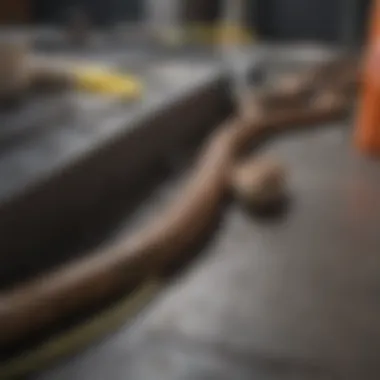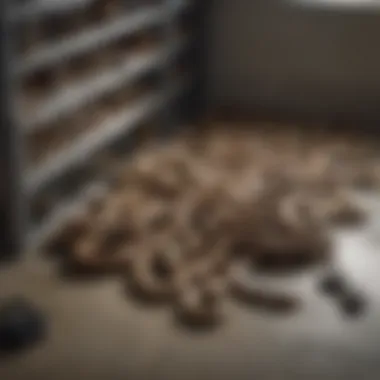Ultimate Guide to Cleaning Your Drain Snake


Intro
Cleaning plumbing tools, especially drain snakes, is crucial for their proper functionality and longevity. A well-maintained drain snake can prevent clogs and ensure a smooth drainage system. This guide delves into effective methods for cleaning your drain snake after use, covering essential materials, techniques and considerations. Whether you are a homeowner or a professional, understanding how to properly clean your drain snake will enhance its performance.
Feature Spotlight
Importance of Regular Maintenance
Regular maintenance is pivotal. A clean drain snake will operate more efficiently, reducing the chances of future clogs. Dirty tools can lead to cross-contamination, introducing bacteria into your plumbing system. This is particularly important for both hygiene and function.
Key Techniques for Cleaning
- Decontamination: Start by wearing gloves. Scrub the snake with a stiff-bristled brush to remove any debris.
- Disinfecting: After rinsing, use a disinfectant spray to eliminate bacteria. Look for products that are safe for plumbing applications.
- Rinsing: Ensure all cleaning agents are rinsed off thoroughly with water to prevent chemical buildup.
Materials Required
Cleaning a drain snake involves a few essential materials:
- Stiff-bristled brush
- Disinfectant spray
- Bucket for rinsing
Here's a Simple Step-by-Step Guide
- Preparation: Wear gloves and gather your materials.
- Scrubbing: Use the stiff-bristled brush to remove any sludge from the snake.
- Disinfect: Spray the disinfectant evenly along the entire length of the snake.
- Rinse: Rinse thoroughly with water to remove cleaning agents.
- Drying: Allow the snake to air dry to prevent rust or corrosion.
Storage Considerations
After cleaning, proper storage is important. Store your drain snake in a dry place, preferably in a case or bag that prevents exposure to dirt or moisture. This minimizes the risk of future contamination and keeps the tool ready for the next use.
Tip: Regularly inspect your drain snake for any worn parts. Prompt replacements enhance performance.
By following these steps detailed in this guide, you can ensure that your drain snake remains effective and hygienic for its intended purpose. Cleaning might appear tedious, but it pays off in the long run. Invest time in properly maintaining your tools, and they will serve you better.
Understanding Drain Snakes
Drain snakes are essential tools for maintaining the plumbing systems in homes and commercial spaces. Their primary function is to effectively clear clogged drains by reaching deep into pipes to dislodge blockages. Understanding these tools is critical. When you know how drain snakes work and the various types available, you can choose the right one for specific jobs. This knowledge ensures efficiency and effectiveness in drain cleaning, and helps to prevent potential plumbing issues before they escalate.
Types of Drain Snakes
There are several types of drain snakes, each designed to tackle specific clogs and situations. The most common types include:
- Handheld Drain Snakes: These are usually manual tools that are simple to operate. They are ideal for minor clogs in sinks and tubs.
- Electric Drain Snakes: These models are powered by electricity and can remove tougher blockages. They are often used by professional plumbers due to their higher efficiency.
- Toilet Augers: Specifically designed for toilets, these snakes have a curved end to navigate the unique shape of toilet traps.
- Plumbing Snakes: These are more robust and suitable for larger pipes, often used in commercial settings.
Understanding the different types enables users to select the most effective tool for the task at hand, enhancing overall satisfaction and reducing frustration.
Functionality and Use Cases
Drain snakes function by using a flexible metal cable that can navigate through plumbing systems. The end of the snake is equipped with a coil or auger, designed to break apart clogs or retrieve solid objects. They are invaluable in various scenarios:
- Clearing Hair and Grease: In residential settings, hair accumulation in bathroom sinks and grease build-up in kitchen sinks are common issues. A drain snake penetrates these clogs and allows for easy removal.
- Removing Tree Roots: In some cases, tree roots can intertwine with residential plumbing. Professional plumbers often use heavy-duty snakes to address these complex blockages.
- Routine Maintenance: Regular use of a drain snake can be an effective preventative measure. It helps to maintain clear pipes and prevent future clogs, saving time and money on emergency plumbing services.


In summary, understanding the types and functionalities of drain snakes is crucial for effective plumbing maintenance. Their use not only improves the functioning of plumbing systems but also promotes overall hygiene and efficiency.
Importance of Cleaning After Use
Cleaning a drain snake after use is not just a good practice; it is an essential step that impacts the tool's functionality, longevity, and hygiene. Regular maintenance ensures that the drain snake remains effective and safe for future use. Each time a drain snake is used, it comes into contact with debris, grime, and potentially hazardous materials. Neglecting proper cleaning can lead to a series of complications that go beyond simple equipment wear and tear.
Preventing Corrosion
Corrosion can occur when drain snakes are exposed to moisture and organic waste without proper cleaning. Wet conditions make metal components more susceptible to rust, which can damage the structure of the snake. If a drain snake is not cleaned promptly after its use, traces of organic materials can lead to further moisture retention. This creates an environment conducive to corrosion, diminishing the appearance and functionality of the tool. Regular cleaning not only removes debris but also mitigates the risk of rust, extending the lifespan of the equipment significantly.
Maintaining Effectiveness
The effectiveness of a drain snake relies heavily on its ability to function without obstruction. If debris remains on the snake after use, it can impede its performance during future applications. For instance, hair, grease, or residue can accumulate, making it much harder for the tool to navigate through pipes. By taking the time to clean the drain snake after each use, users ensure optimal functionality. A well-maintained drain snake is more reliable and can efficiently tackle clogs, saving time and reducing the risk of further plumbing issues.
Health and Safety Concerns
Poor cleaning practices pose health risks that are often overlooked. Drain snakes come into contact with waste substances that may harbor harmful bacteria and pathogens. When these substances are not adequately cleaned off, the risk of spreading germs increases. Moreover, a contaminated snake could expose the user to unpleasant odors and toxins when stored improperly. By ensuring thorough cleaning followed by proper disinfection, users can significantly reduce health risks and maintain a safe working environment.
"The cleanliness of plumbing tools like drain snakes directly affects both their effectiveness and the health of those using them."
Materials Needed for Cleaning
When cleaning a drain snake, having the right materials is an essential component to ensure thorough and effective cleaning. Each item plays a specific role that contributes to the maintenance of the snake’s functionality and lifespan. The correct materials can help to remove accumulated debris effectively, prevent damage to the equipment, and maintain hygiene.
Cleaning Solutions
Selecting appropriate cleaning solutions is vital when it comes to sanitizing a drain snake. These solutions work to dissolve accumulated residues, such as hair and grease, while also disinfecting the surface. Commonly used solutions include a mixture of hot water and vinegar, and bleach for more stubborn stains.
- Hot Water and Vinegar: This combination helps to break down minor clogs, making the removal of debris easier. It is a natural alternative and does not produce toxic fumes.
- Bleach: This is useful for its strong antibacterial properties. However, caution is needed, as it can cause wear on certain materials and produce harmful fumes when mixed with other substances.
It is critical to adhere to the manufacturer’s recommendations regarding cleaning solutions. Using improper agents can lead to corrosion or degradation of the snake material.
Protective Gear
Using protective gear during the cleaning process cannot be overstated. A drain snake comes in contact with waste materials that may harbor bacteria and other harmful pathogens. Essential protective gear includes gloves and goggles.
- Gloves: These should be made of thick, durable material to provide adequate protection from sharp objects and harmful substances. Nitrile gloves are a good choice, as they are both sturdy and chemical-resistant.
- Goggles: Eye protection is crucial to avoid splashes from cleaning solutions. Proper eyewear protects the eyes from irritating chemicals and unintended debris.
Neglecting to wear protective gear can expose one to health risks associated with waste materials, often overlooked during cleaning.
Tools for Removal of Debris
Having the right tools for debris removal can significantly simplify the cleaning process. Generally, tools should be solid and effective in handling large debris. Some common tools include:
- Wire Brush: Ideal for scrubbing off any stubborn residues on the surface of the snake, ensuring that no debris is left behind. It helps maintain a clean working condition.
- Bucket: A bucket provides a place to mix cleaning solutions and effectively manage any waste accumulated during the cleaning process. It provides convenience and organization.
- Old Towels or Rags: These are handy for wiping down the snake after cleaning. They absorb moisture and assist in ensuring no cleaning solution remains.
Having these tools at hand can streamline the cleaning process and prevent any delays during maintenance.
Proper material selection is central to maintaining a drain snake's cleanliness and operational integrity.
Step-by-Step Cleaning Procedure


Cleaning a drain snake thoroughly after use is crucial. This procedure directly impacts its efficiency and lifespan. By following a systematic approach, users can ensure that their tools remain functional and safe. Furthermore, a well-cleaned drain snake minimizes the risk of transferring harmful bacteria or debris to other areas. Therefore, adhering to a structured cleaning process is beneficial for both the user and the environment surrounding them.
Initial Inspection
Start with an initial inspection of the drain snake. Check for visible damage like bends, cracks, or corrosion. Assess the overall condition of the snake. This step helps in understanding the extent of cleaning required. If damage is noted, it may necessitate repairs or even consider replacing the tool. Not taking this step can lead to further complications when using a damaged snake in future jobs.
Debris Removal
Once the inspection is complete, proceed to debris removal. Remove larger clumps of hair, grease, and other substances that may cling to the snake. Utilize gloves to protect your hands during this process. A stiff brush or scraper can be useful in dislodging stubborn material. Ensure all debris is cleared, as any residue left can lead to corrosion or blockage in the future. Avoid harsh scraping that can damage the surface of the snake.
Disinfection Process
Once the debris is removed, focus on the disinfection process. It is essential to disinfect the drain snake to eliminate any remaining germs or bacteria. A solution of vinegar and water can be effective; alternatively, a suitable commercial cleaner can be used. Apply the disinfectant using a cloth or sponge, ensuring complete coverage of the snake's surfaces. Allow it to sit for the recommended time before rinsing with clean water. This step greatly enhances hygiene and prevents possible health hazards.
Drying the Snake
Finally, after the disinfection process, drying the snake is paramount. Any moisture left can create a breeding ground for bacteria or cause rust. Use a clean, dry cloth to wipe down the snake thoroughly. Afterward, place the snake in a well-ventilated area to ensure that all moisture evaporates. Storing it in a dry location will preserve its condition and extend its service life.
Regular cleaning and maintenance of plumbing tools such as drain snakes are vital for health and efficiency, ensuring smooth plumbing operations in any household.
By following these four succinct steps, individuals can maintain their drain snakes effectively. Each step plays a critical role in ensuring the longevity and optimal performance of this essential plumbing tool.
Storage Recommendations
Effective storage of your drain snake is crucial for maintaining its longevity and functionality. A poorly stored drain snake may suffer damages or corrosion, rendering it less effective next time you need it. Determining the right way to store a drain snake involves careful consideration of aspects such as location, protection from external factors, and overall organization.
Choosing the Right Location
The location where you store your drain snake can have significant implications on its condition over time. Ideally, place your drain snake in a dry, cool area that is away from direct sunlight. High temperatures and humidity can promote rust and affect the materials from which the snake is made. Here are some key points to focus on:
- Accessibility: Store your drain snake in a location that is easy to access, like a designated tool shed or utility room. This will encourage regular use and maintenance.
- Separation from Other Tools: Keep the drain snake separate from other tools that may cause abrasion or damage. For instance, sharp tools can create unintended cuts on the cleaner.
- Consideration for Space: Ensure that the storage location has ample space. Avoid crowding, as this can lead to tangling or other physical damage.
Avoiding Rust and Damage
Rust is one of the immediate concerns when it comes to storing metal tools like drain snakes. Here are several strategies to avoid rust and damage effectively:
- Dry Before Storing: Always make sure the drain snake is completely dry after cleaning. Moisture can lead to rust formation, which diminishes its effectiveness.
- Protective Coating: Applying a thin layer of oil can act as a barrier against moisture, preventing rust. Use a product such as mineral oil or motor oil for this purpose.
- Storage Container: Using a dedicated storage container can provide an extra layer of protection. A plastic bin with a lid or a toolbox can help shield the snake from dust, debris, and potential water exposure.
"Proper storage practices not only extend the life of your drain snake but also ensure its performance when you need it most."
With these mindful storage suggestions, you can significantly reduce the risk of rust and damage to your drain snake, keeping it ready for your plumbing challenges.
Common Mistakes to Avoid
Understanding common mistakes made during the cleaning process of a drain snake is crucial for maintaining the effectiveness and durability of this plumbing tool. Knowing what not to do can prevent damage, ensure hygiene, and prolong the snake's lifespan. This section will highlight key mistakes to avoid when cleaning a drain snake.
Neglecting Hygiene Practices
One of the most severe mistakes is neglecting hygiene practices. Cleaning a drain snake is not just about removing debris; it is also about eliminating potentially harmful bacteria and pathogens. After handling a drain snake, it is critical to sanitize the equipment to avert health risks.


Several offenders often overlook proper washing of hands after cleaning. This minor act can lead to the spread of contaminants. Always ensure you wash your hands thoroughly with soap and water after the cleaning process.
Additionally, avoid using the same cleaning cloth or sponge that you use for other household items. This can transfer unwanted germs back onto the equipment. It is always recommended to dedicate specific cleaning tools to the drain snake to maintain high sanitation standards. Furthermore, keeping the cleaning area tidy helps prevent any cross-contamination as well.
Using Improper Cleaning Agents
Another common mistake involves using improper cleaning agents for the drain snake. Many people may resort to household chemicals not intended for cleaning plumbing tools. Using strong, abrasive cleaners can damage the material of the drain snake itself, affecting its functionality.
Opting for a mild detergent mixed with warm water generally yields favorable results without harming the snake’s surface. A solution of vinegar and baking soda can also be effective and more environmentally friendly. It is important to read the manufacturer's recommendations or guidelines provided with the equipment to identify suitable cleaning agents.
Moreover, avoid using corrosive substances such as bleach or heavy-duty solvents, which may lead to rusting or degrading of the tool. By selecting the right cleaning agents, users can maintain the integrity of the drain snake over time, ensuring its readiness for the next use.
Remember, proper maintenance starts with understanding what practices to avoid for optimal performance.
Professional Cleaning Options
Cleaning a drain snake after use is often straightforward for many homeowners. However, there are situations when the fouling or damages require a more thorough intervention that only professionals can provide. This section offers insight into when and how to select a reliable service provider for these cleaning needs.
When to Consider Professional Services
Professional cleaning services are essential in certain situations. If your drain snake has been heavily soiled or damaged, overseeing this process alone might not achieve the desired results. Here are key indicators suggesting that it may be time to seek professional help:
- Extensive Build-Up: If you notice significant clogs that your usual methods cannot clear, a capable service team can come equipped with industrial cleaning tools.
- Persistent Odors: Unpleasant smells can indicate that the snake has absorbed bacteria. In such instances, professionals hold the expertise to conduct deep sanitization procedures.
- Physical Damage: Signs of wear or damage, such as bent coils or rust, necessitate an evaluation from an expert. Repairing or replacing a drain snake can be costly, and a professional will provide the right insight on the most effective route forward.
- Lack of Knowledge: If you lack confidence in your cleaning methods, contacting experts can save time and resources.
Selecting a Reliable Service Provider
Choosing a trustworthy service provider is critical to ensuring that the job gets done correctly. A wrong choice can lead to inadequate cleaning, potential damage, or rising costs. Consider the following factors when selecting a provider:
- Experience and Credentials: Look for companies with a proven track record in plumbing or drain cleaning. Verify their credentials to ensure they have received the necessary training.
- Reviews and Recommendations: Check online platforms such as Reddit or Facebook for reviews. Personal recommendations from friends or family can also lead you to reliable professionals.
- Pricing Transparency: A trustworthy service will provide clear pricing. Always request a quote before work begins to avoid surprising costs.
- Insurance and Warranties: Ensure that the service provider carries liability insurance. This protects you from any damages that may occur during the cleaning process.
Engaging a professional service can not only enhance the effectiveness of your cleaning efforts but also extend the life of your drain snake, making it a wise investment in the long run.
Engaging professional cleaning options for your drain snake may not be necessary for all situations, but being informed on when to utilize these services can save you time, effort, and money.
Finale
Cleaning a drain snake is not just a matter of hygiene; it is essential for preserving the tool’s performance and longevity. By understanding the importance of regular maintenance, users can prevent future clogs and ensure their tool operates at its best. In this article, we covered various aspects of cleaning and maintaining a drain snake. The steps outlined, such as proper disinfection and drying techniques, are vital practices.
Moreover, by effectively removing debris and utilizing appropriate cleaning agents, one can avoid rust and deterioration. These actions lead to enhanced efficiency and reduce the risk of health issues related to unclean plumbing tools. Keeping your tools in top condition reflects a commitment to quality, whether for personal use or professional applications.
"Regular maintenance can prolong the life of your drain snake and prevent costly repairs or replacements."
Ultimately, the benefits of keeping your drain snake clean are manifold. From bolstering its functionality to fostering a healthier environment, consistent care sets a standard for tool management in plumbing tasks. It is clear that a clean tool is a more effective tool.
Summarizing Key Points
To encapsulate, the key points discussed include:
- Cleaning is crucial to maintain the performance of a drain snake.
- Regular inspection and maintenance prevent buildup of debris.
- Disinfection techniques are vital for health and safety.
- Proper drying and storage practices can prevent rust and damage.
These elements highlight the importance of integrating cleaning practices into routine maintenance of plumbing tools. A conscientious approach helps avoid complications that could arise from negligence.
Encouraging Regular Maintenance
Encouraging regular maintenance of a drain snake works to emphasize the value of preventive care. Simple habits, such as cleaning after each use and storing the tool in a dry place, can significantly reduce future headaches. It is beneficial to establish a cleaning schedule that aligns with usage frequency, thus making care manageable.
Additionally, sharing tips about effective cleaning agents and tools can inspire others to adopt these practices. Visual reminders, like checklists, may be employed in workshops or personal spaces to reinforce proactive management of plumbing tools. In this way, individuals can not only protect their investment but also contribute to safer and cleaner home environments.







